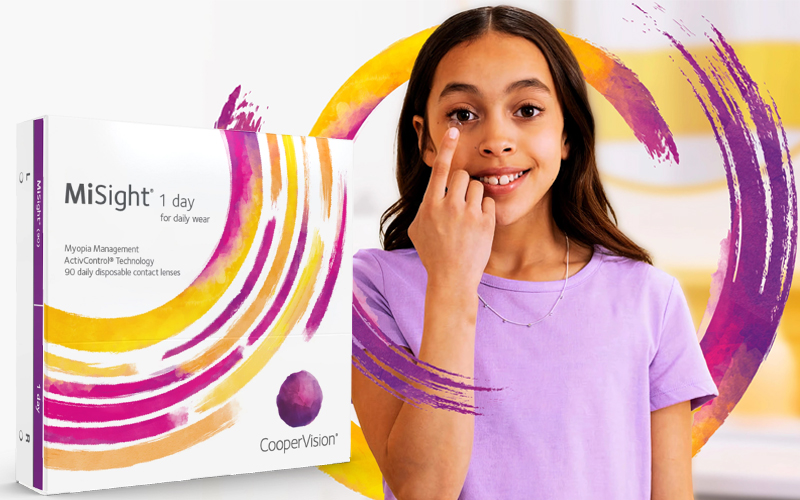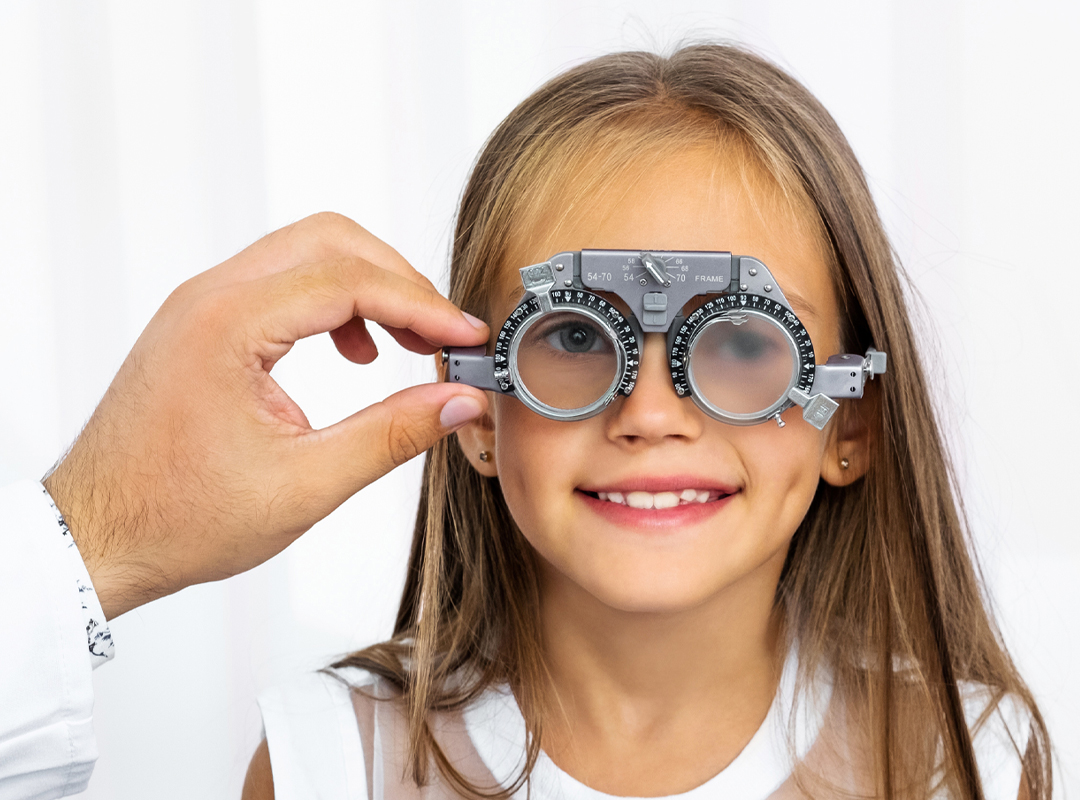Comprehensive Myopia Control: A Deep Dive into Prevention and Management
Understanding Myopia Progression and Implementing Evidence-Based Strategies to Preserve Lifelong Vision Clarity, Reduce Risks of Ocular Complications, and Support Pediatric Eye Health.
Details- Published: February 15, 2025
- Author: Dr. Harina Thyriar, Optometrist (Certified in Ocular Pathology)
- Focus: Myopia Control & Prevention
- Location: Mont-Royal, Québec

Why Myopia Control Matters
Myopia is becoming increasingly common in children worldwide, raising serious concerns about long-term ocular health. At HARINA Optométristes, we are committed to delivering evidence-based insights into myopia progression, its potential complications, and modern methods of control.
Through clinically proven solutions such as Essilor® Stellest® lenses and CooperVision MiSight® 1 day contact lenses, our team helps slow the progression of myopia and reduce future vision-threatening risks.
Discover how our tailored approach combines advanced diagnostic technology, preventative care, and personalized treatment plans — all designed to safeguard your child’s visual health and overall well-being for the long term.
Understanding Myopia: More Than Just Blurry Vision
Myopia, or nearsightedness, is more than just difficulty seeing distant objects. It is a progressive condition that, if left unchecked, can lead to severe complications such as retinal detachment, glaucoma, cataracts, and myopic maculopathy. Controlling myopia is essential not only for clear vision but also for preventing long-term eye diseases.
The Importance of Myopia Control
Myopia control is crucial not only for improving immediate vision but also for safeguarding long-term eye health. High myopia, often resulting from unchecked progression during childhood, significantly increases the risk of severe ocular conditions later in life. These conditions include:
- Retinal Detachment: As the eye elongates due to myopia, the retina becomes stretched and thinner, making it more susceptible to tearing or detachment, which can lead to vision loss if not treated promptly.
- Glaucoma: Myopic eyes are at a higher risk of developing glaucoma, a condition characterized by increased pressure within the eye that can damage the optic nerve and result in permanent vision impairment.
- Cataracts: Individuals with high myopia are more likely to develop cataracts at an earlier age. Cataracts cause the eye’s natural lens to become cloudy, leading to blurred vision and, if untreated, blindness.
Early intervention through myopia control during childhood is essential. As children's eyes are still developing, managing myopia at this stage helps slow down its progression, reducing the risk of these serious complications and ensuring better visual outcomes in adulthood. Myopia control also enhances quality of life by minimizing the need for stronger prescriptions over time and preserving clearer vision for longer periods.
Myopia Control vs. Regular Lenses

While traditional eyeglasses and contact lenses are designed to correct blurry vision by focusing light directly onto the retina, myopia control lenses serve a dual purpose: correcting vision and actively slowing the progression of myopia. The key difference lies in how these specialized lenses manipulate light.
- Regular Lenses: Provide clear vision by adjusting the focal point of incoming light so that it lands precisely on the retina, compensating for the elongation of the eye in myopic individuals.
- Myopia Control Lenses: Employ advanced optical designs, such as peripheral defocus, to influence eye growth. By focusing light slightly in front of or around the retina’s periphery, these lenses send signals to the eye to slow its elongation, thereby reducing the rate at which myopia progresses.
Early intervention through myopia control during childhood is essential. As children's eyes are still developing, managing myopia at this stage helps slow down its progression, reducing the risk of these serious complications and ensuring better visual outcomes in adulthood. Myopia control also enhances quality of life by minimizing the need for stronger prescriptions over time and preserving clearer vision for longer periods.
Myopia control methods include:
Orthokeratology (Ortho-K)
Rigid lenses worn overnight that reshape the cornea temporarily, providing clear vision during the day and slowing myopic progression.
Multifocal Contact Lenses
Soft lenses with multiple zones for different focusing distances, encouraging slower eye growth.
Specialized Spectacle Lenses
Such as Essilor® Stellest® lenses, which incorporate a constellation of lenslets to create a myopia control signal while ensuring clear central vision.
By choosing myopia control over regular lenses, parents and eye care professionals invest in a child’s future ocular health, reducing the risk of high myopia and its associated complications, while also providing clear, comfortable vision during crucial developmental years.
Essilor® Stellest® Lenses: Revolutionizing Myopia Management

Stellest® lenses by Essilor® are designed with cutting-edge H.A.L.T. (Highly Aspherical Lenslet Target) technology. Each lens is embedded with 1,021 tiny aspherical lenslets arranged in a pattern that creates a peripheral defocus signal, slowing down eye elongation. Clinical studies reveal that children wearing Stellest® lenses experience up to 67% slower myopia progression compared to those using standard single-vision lenses. Stellest® lenses also provide:
- Clear central vision with no compromise on visual quality.
- Long-term protection against high myopia-related complications.
- Lightweight design for everyday comfort.
The innovation behind Stellest® lenses stems from decades of research, making them a top choice for parents seeking effective myopia control for their children.
CooperVision MiSight® 1 day Lenses: Innovation Meets Convenience

MiSight® 1 day lenses by CooperVision are the world’s first FDA-approved soft contact lenses for myopia control. Utilizing ActivControl® technology, these lenses have concentric rings that create alternating zones of vision correction and myopic defocus. Research demonstrates that MiSight® lenses reduce myopia progression by 59% over three years. Additional benefits include:
- Daily disposable convenience, ensuring hygiene and ease of use.
- Suitable for children as young as eight years old.
- Maintained visual acuity while actively controlling myopia progression.
MiSight® lenses are particularly advantageous for active children who need freedom from eyeglasses while benefiting from effective myopia control.
Research and Innovations in Myopia Control
The field of myopia control is continuously evolving, with ongoing research shedding light on new methods to better manage and slow the progression of myopia in children and young adults. Key areas of innovation include:
- Genetic Influences: Researchers are delving into the genetic predisposition to myopia, aiming to identify specific genes linked to the development and progression of nearsightedness. Understanding these genetic markers could pave the way for personalized myopia management strategies tailored to an individual's genetic profile.
- New Lens Technologies: Advanced optical designs are at the forefront of myopia control. Lenses like Essilor® Stellest® and CooperVision MiSight® 1 day are already leading the charge, but researchers are working on next-generation lenses that may offer even greater efficacy. Innovations include dynamic lenses that adapt to varying visual environments and digital eye strain, providing continuous control throughout a child’s day.
- Combination Therapies: Studies are exploring the potential benefits of combining different myopia control methods for enhanced outcomes. For example, combining low-dose atropine eye drops with myopia control lenses has shown promising results in slowing eye elongation more effectively than using a single method alone. Researchers are also investigating the synergy between orthokeratology and pharmaceutical interventions to achieve better control.
- Environmental and Behavioral Studies: Research has highlighted the role of environmental factors in myopia progression, such as limited outdoor time and excessive near-work activities like reading or screen use. Innovations in myopia control now emphasize lifestyle modifications alongside optical treatments, encouraging outdoor play and managing screen time to help slow the progression of myopia.
These continuous advancements in myopia control ensure that eye care professionals can offer increasingly effective solutions to manage myopia, ultimately protecting long-term eye health and improving visual outcomes for children worldwide.
When to Consider Myopia Control for Your Child

Recognizing the early signs of myopia in children is crucial for timely intervention. Parents should consider myopia control if they observe any of the following symptoms or behaviors in their child:
- Frequent Squinting: Squinting is often a sign that a child is struggling to see distant objects clearly, indicating the onset of myopia.
- Sitting Too Close to Screens or Books: Children with myopia often instinctively move closer to screens, books, or the television to see more clearly. This behavior can further strain their eyes and accelerate myopia progression.
- Rapid Prescription Changes: If your child’s prescription needs to be updated frequently (e.g., every 6-12 months), it could be a sign of progressive myopia, and myopia control measures should be considered to slow down this rapid change.
- Complaints of Blurred Distance Vision: Children may mention difficulty seeing the board at school or recognizing distant objects, which can affect their academic performance and daily activities.
- Eye Fatigue or Headaches: Prolonged near-work, such as reading, using digital devices, or doing homework, can cause eye strain and headaches in children with myopia.
If any of these signs are present, consulting an optometrist for a comprehensive eye examination is essential. Early intervention with myopia control lenses like Essilor® Stellest® or CooperVision MiSight® 1 day can significantly slow the progression of myopia, reducing the risk of severe eye conditions in adulthood and ensuring better long-term vision for your child.
Explore more from HARINA Eye Health HUB
Loading Docs... real-world examples, patient journeys, or clinical success stories.
Loading Docs... downloadable documents, research papers, guidelines, and/or charts.
Take the First Step
Towards Protecting Your Child’s Vision
With myopia control solutions, you can help safeguard their vision for the future. Schedule an eye examination today at HARINA Optométristes to explore personalized myopia control options and give your child the clear, healthy vision they deserve.





